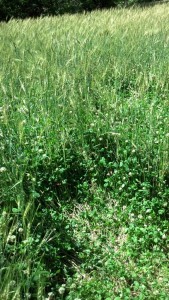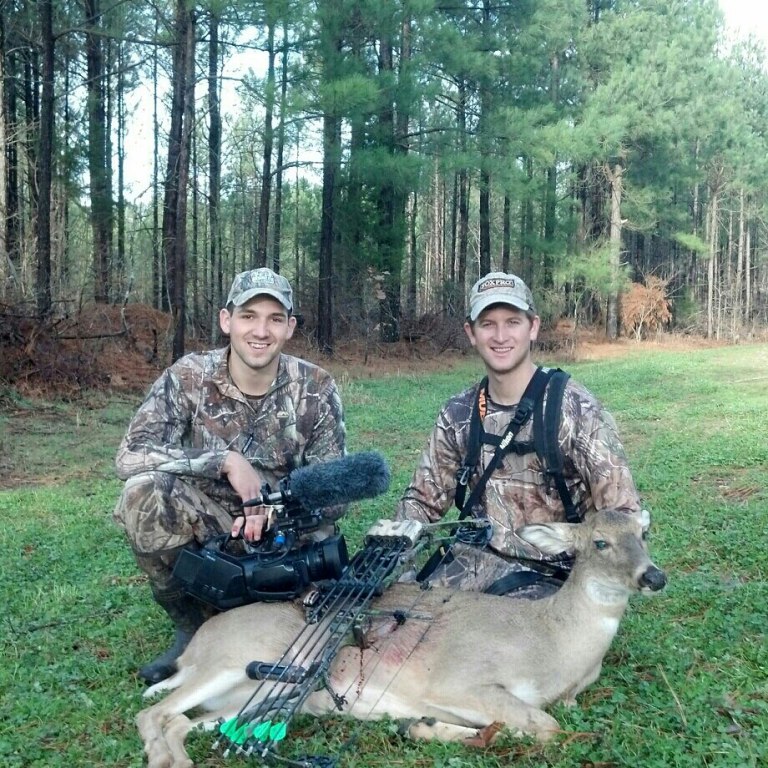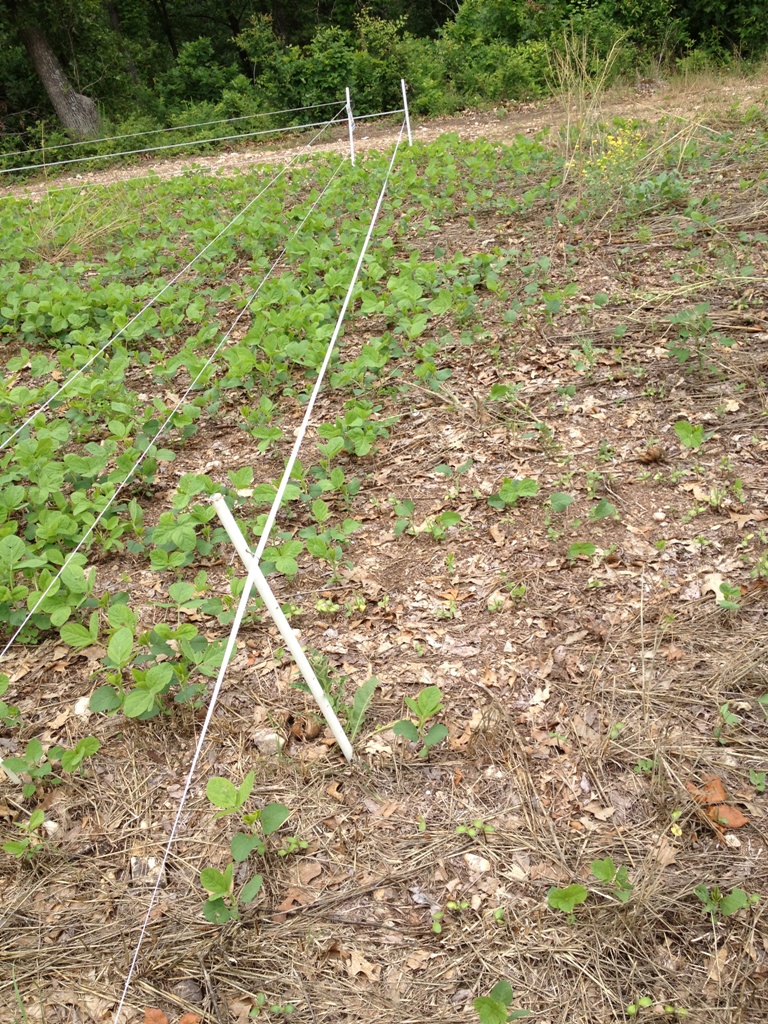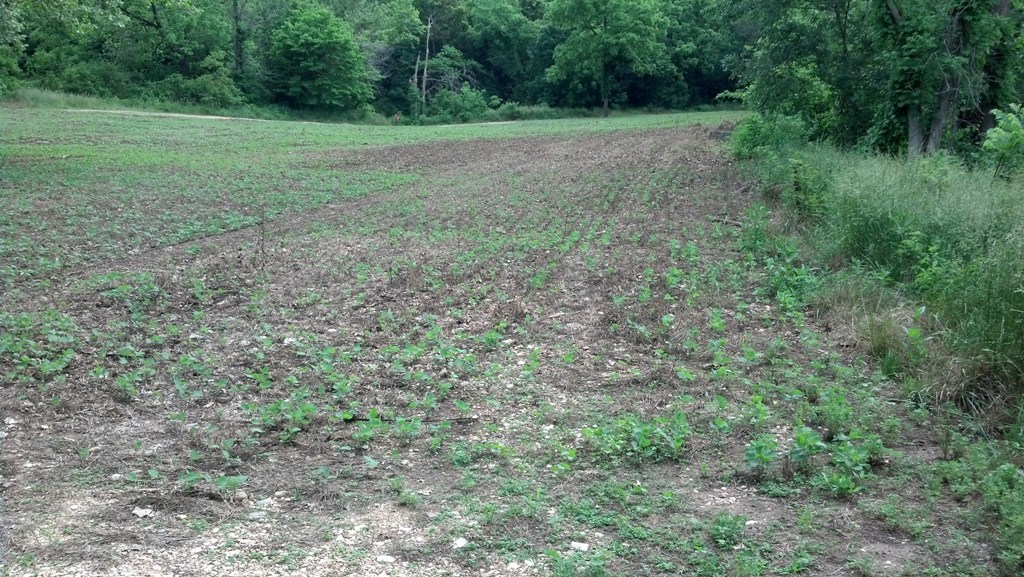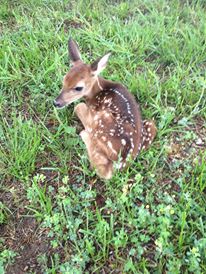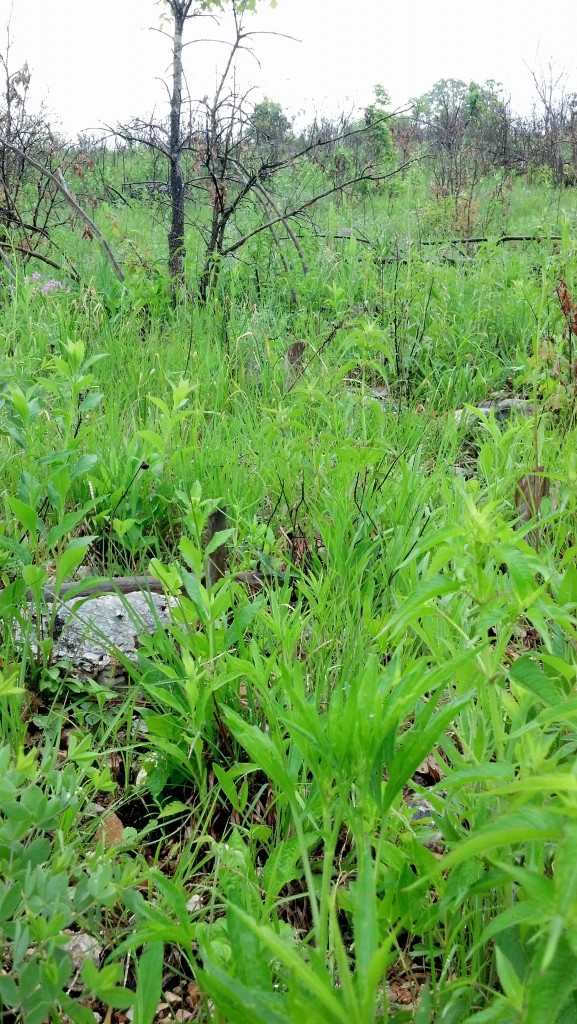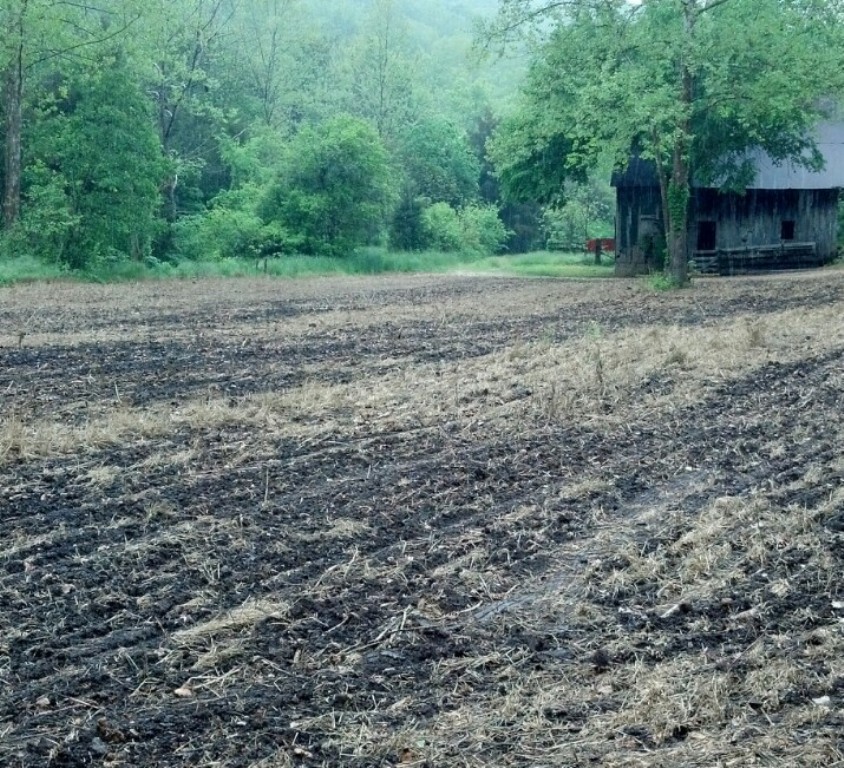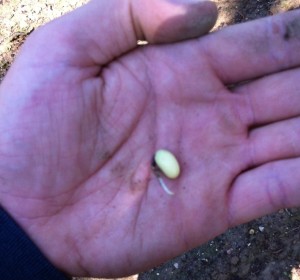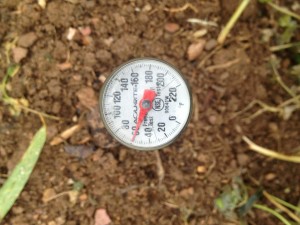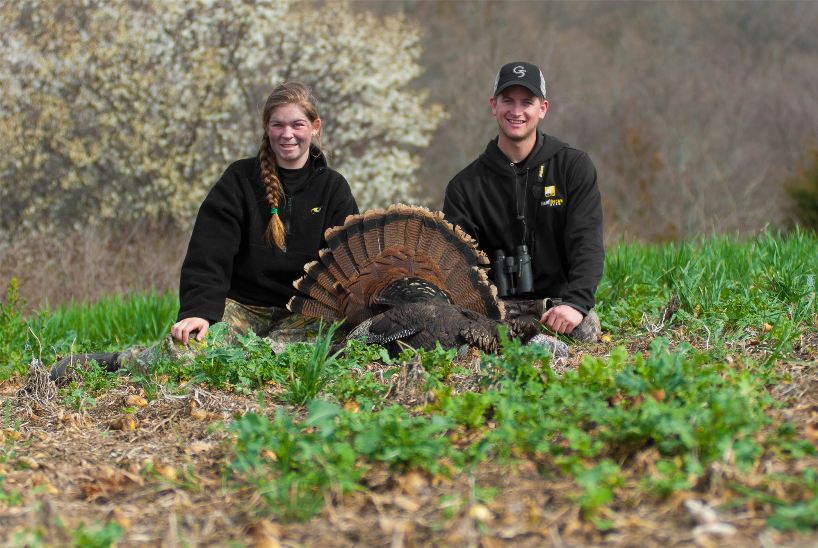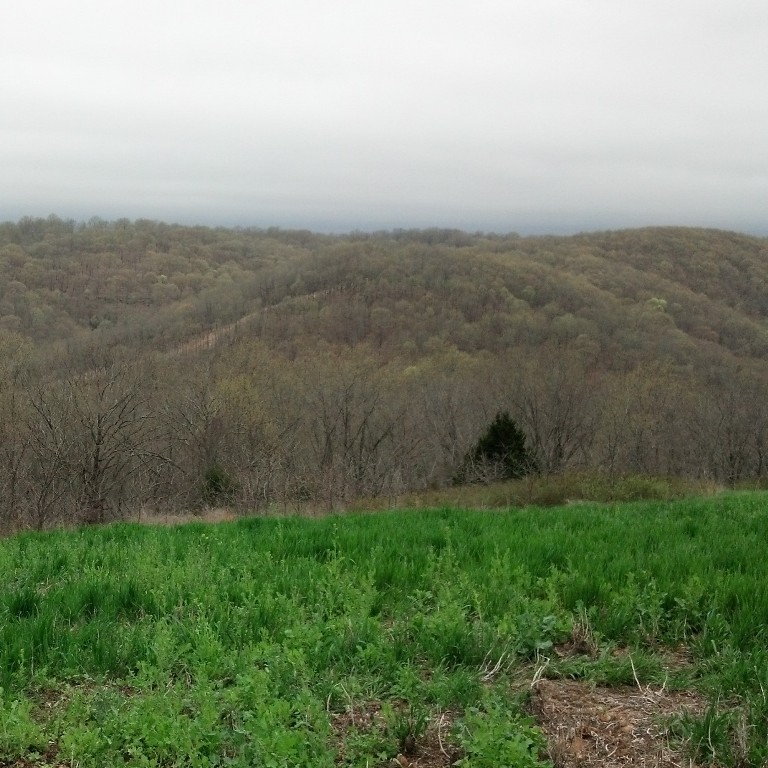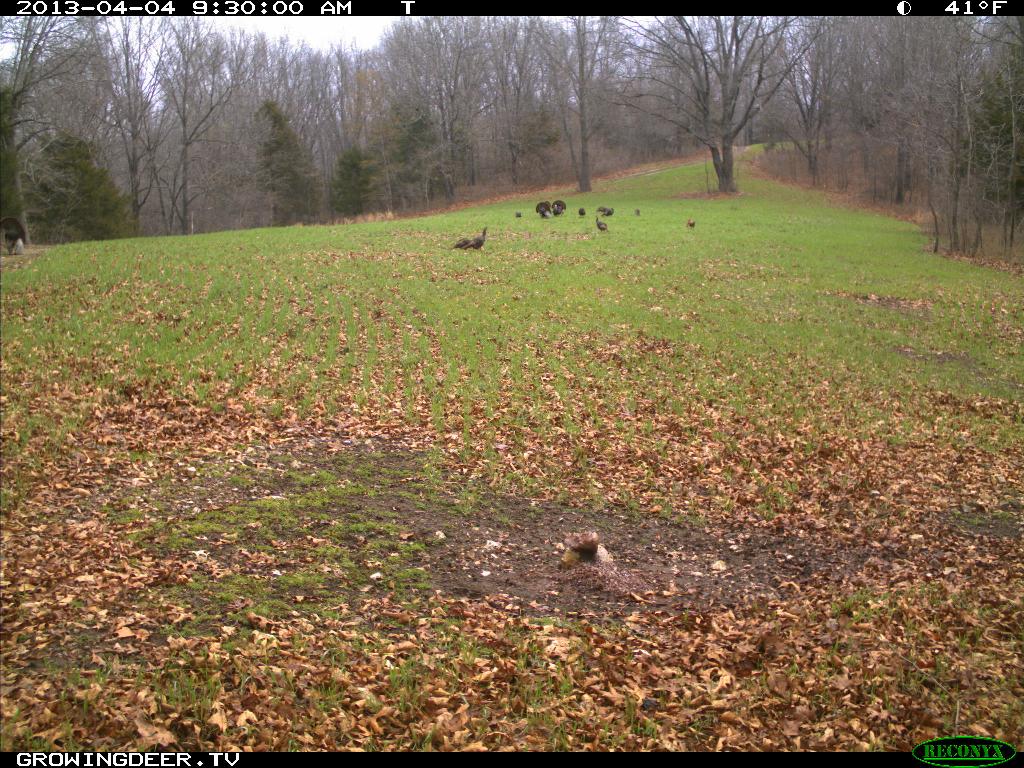Category: Hunting Blog
Whitetail Bucks In Summer Velvet: How Big Will He Be?
I receive a lot of questions this time of year about what percentage of a buck’s antlers have been produced to date. The questions are usually phrased “Will the antlers double in size between now and when the velvet sheds?” or “Will he grow more points and tine length before hunting season?”
These are great questions and they are difficult to answer with certainty! First, bucks are unique individuals just like humans. Some folks seem to grow a bunch early during their life while others have a growth spurt later. Some bucks will show a lot of antler growth early while others seem to add a bunch to their rack during July.
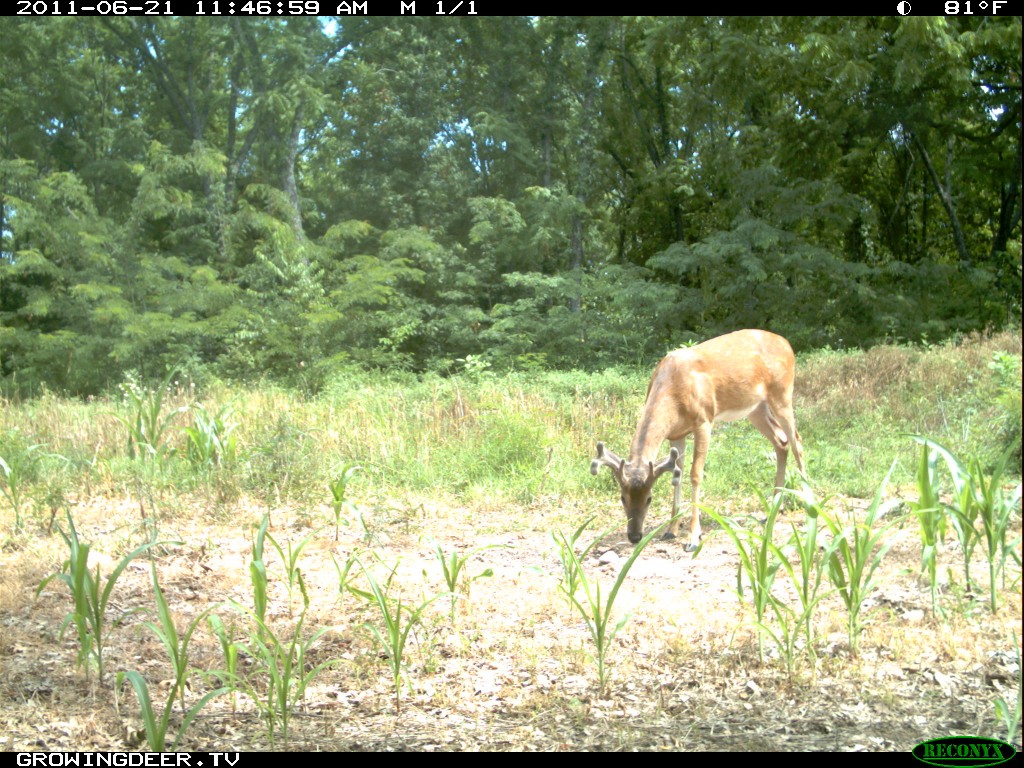
Scouting for bucks in mid June is a great way to estimate the quality of bucks that will be in the area when season opens!
Bucks will have most of their beam length developed by this week. Most of their points will be showing by mid June. Some bucks will have all points showing and some will add a few points. However, tine length is likely to be less than half developed at this time. That’s a big factor as tine length usually makes up about 40% of total gross score!
Mid June is a good time to begin scouting for mature bucks. I use both my Reconyx trail cameras and Nikon binos! Remember that mature bucks clearly have some level of memory. Therefore make sure to use good scent control techniques when checking trail cameras this time of year! The guys and I here at The Proving Grounds use Dead Down Wind. It’s based on safe enzymes – not harmful bactericides like most other products on the market. The best time to check your trail cameras is the middle of the day when deer are most likely to be bedded down.
We are seeing lots of daylight deer activity right now at The Proving Grounds. Deer are hitting our food plots hard in the early morning and late afternoon. We’ve been excited to see a good number of fawns and a significant number of velvet antlered bucks. Remember that antlers in velvet look much larger than what you will actually see this fall.
Scouting for bucks is a great way to estimate the quality of bucks that will be in the area when season opens!
Growing and hunting deer together,
Grant
How To Grow The Best Clover Food Plot
There are numerous types of clover that hunters use across the nation to provide quality food plot forage for deer and other wildlife. Here at The Proving Grounds it’s no different. We typically plant Eagle Seed soybeans in our food plots. They are awesome for providing food for whitetails, turkey, and other critters for 11 months out of the year. By combining a healthy stand of clover with Eagle Seed soybeans you can continue attracting and holding whitetails on your property.
We typically try to plant at least 10% of our food plot acreage in some type of clover. Clover is an essential food plot crop as it is one of the varieties that helps fill the void in early spring when our Eagle seed beans have matured and the pods have been completely removed by wildlife. This time period usually falls middle to late February and lasts through late March. If you’re familiar with clover you’ve probably noticed that during that time of year clover can provide lots of forage. This is important as our Eagle seed beans are at their lowest point of productivity. Clover and Eagle Seed soybeans fill each other’s void beautifully, and together they are quite the deadly duo of food plots.
This past week we’ve worked managing our clover to ensure it’s in the best form it can be. There are two simple steps that need to be performed on clover food plots. First, provide clover with a high quality fertilizer so it doesn’t starve; we do this by adding Antler Dirt! The second important part in clover management is weed control, especially in first year stands of clover. We use a broadleaf herbicide combined with a grass specific herbicide and then add a non-ionic surfactant to form a clover cocktail. We then use the cocktail to spot spray our clover fields. There are benefits to using herbicide in a clover plot instead of mowing. The herbicide is taken in by the plant, killing it all the way to the roots, preventing any future growth of that plant. When mowing, you’re just removing the top section of the weeds and probably not killing the plant roots, resulting in regrowth.
Clover should be a part of every wildlife manager’s arsenal because it not only provides tons of forage for wildlife but it also can create a great spot for hunting! Check out episode #165 to see the GrowingDeer Team take advantage of the clover at The Kentucky Proving Grounds!
Daydreaming of Whitetails,
Adam
How To Create A Red Hot Hunting Spot
Deer love grain (carbohydrates/energy) during deer season. This is why they are so attracted to acorns, corn, etc. Corn can be very tough to grow in a food plot environment, especially small food plots. Another source for carbohydrates are Eagle Seed forage soybeans. They are easy to grow even in small plots! Deer LOVE to browse on soybeans, especially young soybeans.
However, depending on the number of deer and amount of food in the area deer can damage young soybeans by browsing them so intensively they can’t grow. Since deer love soybean pods I want to ensure some soybeans in smaller food plots aren’t over browsed and mature to make pods!
A few years ago I started using electric fences to successfully protect food plot crops until it was time to hunt over them. I was amazed that a two foot tall electric fence will keep deer out of a food plot that had tasty young soybeans!
The fence works because of the overall design. The key is to place one ½” white electric fence tape 18” above the ground around the outside edge of the forage you wish to protect. Go in toward the forage three feet and place another layer of fence with two wires – one 10” and one 24” above the ground. There are great diagrams and instructions at the Hot Zone Deer Exclosure System webpage.
The system is powered by a solar panel that trickle charges a battery – so the fence is hot 24/7. I’ve been amazed at forage growth inside versus outside the fence. I’ve seen soybeans be lip high outside the fence and over four feet tall inside the fence! When I’m ready to hunt I will simply remove the fence or create a gap! Deer will find the gap within just a few days so it’s important to have a stand in place before hunting season!
I’ve reused the same fence for multiple years. It’s a great tool to create a honey hole where you want it – where you can approach or exit the stand without spooking deer and the common wind direction is favorable for hunting!
I didn’t like putting up fences on our farm as a kid. I really enjoy it now knowing the payoff is a red hot stand location!
Growing (and hunting) deer together,
Grant
Food Plot Damage By Groundhogs
I’ve noticed a trend during recent years of an increasing number of reports of groundhogs damaging food plots. Groundhogs, called woodchucks in some areas, are rodents and strict vegetarians. They love to eat and prosper on soybeans, peas, and clover – all common warm season food plot crops.
Groundhogs breed during the early spring and usually have 2 to 6 offspring with 4 being the most common. It’s easy to see how groundhog sightings can go from rare and novel to common in a few years. Similarly, damage to food plot crops can go rapidly from non-existent to extensive.
A few years ago groundhog sign and sightings were rare at my place. Now there’s evidence of groundhogs at every one of my food plots. Some of my food plots show sign of extensive damage. Groundhogs tend to begin eating soybeans and other annual forages as soon as they germinate and literally kill the plants by eating them to the ground. Their damage is fairly obvious as it is almost always in a semi circular pattern from the edge of the field where their dens usually are.
I like groundhogs, but I don’t like them destroying food plot crops and depriving other forms of wildlife from access to quality forage. Therefore it’s necessary to attempt to reduce the population to a level where the damage they cause is acceptable.
Groundhogs have a good sense of smell and vision. They are very challenging to hunt and make tasty table fair! Small calibers like a .223 are perfect for groundhogs, especially when paired with rapidly expanding ammo like Winchester Varmint X!
Trapping is a better solution where groundhogs are a serious problem. I use the same Duke cage traps I use for catching raccoons during the winter. Almost any type of fresh fruit works well as bait. I prefer cantaloupe as it has a very strong aroma that will last for a few days, even during the heat of the summer. The best success occurs when the trap can be placed within a few feet of the groundhog’s den or directly in the trails that lead from their den to where they feed.
In good habitat (like by a lush food plot) groundhogs often have very small home ranges of 200’ or less. Groundhogs tend to be territorial and it’s common to have multiple groundhogs staking out territories on opposites sides of food plots. In these situations, groundhogs will certainly take more than their share of forage and do extensive damage to the food plot crop. As part of this damage, they limit the amount of quality forage available to other species including deer, turkey, and other foraging wildlife.
Hunting groundhogs is a great way to tune up your whitetail skills with either a gun or bow and provide some good fresh meat before deer season! However, if groundhogs are doing substantial damage to food plot crops, trapping them is the best solution.
Growing Deer (and managing food plots) together,
Grant
What To Do When You Find A White-tailed Fawn
Have you ever found a fawn? This is the time of year throughout most of the whitetail’s range that fawns are born! Does typically have fawns in areas of low cover if such habitat is available. This includes areas where turkey hunters might expect to see late season toms trolling for hens. Good turkey nesting habitat is usually good fawning habitat. If such cover isn’t available in an area, does will fawn in fields, yards, along trails, etc.
These are areas that folks frequent and therefore find fawns. I receive a lot of questions each spring about what to do if a fawn is found. Rarely will the doe be seen near the fawn so it’s a logical assumption that the fawn has been abandoned.
That’s rarely the case! Does leave their fawns for hours at a time and only return to the fawn to allow them to nurse during the first few weeks after giving birth. This reduces the amount of scent and movement around the newborn fawns and scientists assume this serves to reduce predation of fawns.
If you find a fawn, snap a quick picture if you please and then simply leave the area. The doe may be watching you, but will rarely show herself. Your scent could serve to attract predators so do the same as the doe and leave the area.
It’s illegal in most states to possess wild, free-ranging living wildlife. In addition, fawns do best when they can feed on their mother’s milk. If you find a fawn at the edge of your yard, keep your pets penned up and it’s likely the doe will move the fawn soon due to the amount of disturbance in that environment. If you find a fawn away from civilization, simply keep moving.
I really enjoy watching all ages of deer. However, when it comes to newborn fawns, I take a quick look and picture, then back out of the area. That’s the best action that can be taken!
Enjoying Deer together,
Grant
Predicting Antler Growth With A Rain Gauge
Remember the saying “April showers bring May flowers?” Early spring showers bring more than flowers. Early spring showers bring antlers!
There is some neat research in south Texas that monitored the amount of rainfall during the early spring months and the average size of antlers produced by each age class of bucks that fall.
The results clearly demonstrated a positive relationship between spring rainfall and antler growth. The smallest average antler size per age class occurred during the two years that the least amount of rain occurred during the early spring months. The years the average antler size per age class was the largest was when the most rain occurred during the early spring months!
Clearly, ample high quality forage during the first portion of the antler growth cycle is strongly related to antler production during that year! This certainly applies to the Texas example where the majority of the land is covered by native vegetation.
I read a report the other day that only 7% of the corn and soybean crops have been planted due to the fields being too wet. The percent of these crops that are planted is way behind the previous two years. In the corn and soybean belt deer are literally forced to consume these cultivated crops as native vegetation is very rare. It’s the only thing on the menu! A wet spring in the corn belt may have the opposite effect on antler size compared to areas where native vegetation can take advantage of the spring rains.
Deer with the largest antlers and body weights are from areas with ample soybean and corn production. However, if the area where those crops are grown remains bare ground during the early spring, there’s not much for the local deer to eat. In these areas spring showers may have the opposite relationship on average antler size per age class compared to an area with quality native vegetation. 2013 is shaping up to be an interesting year for deer hunters and researchers!
Growing Deer (and learning about them) together,
Grant
Spring Food Plots: Conditions for Success
This time of year I receive lots of questions about planting warm season food plots. Recently it has been raining or snowing throughout much of the whitetail’s range. It’s literally too cold or wet to plant in many regions.
Most crops that are planted this time of year have a relatively large and soft seed, such as Eagle Seed forage soybeans, corn, sunflowers, etc. These large and soft seeds readily absorb water as part of their germination process. In addition to needing water to break dormancy, they also require a minimal temperature to begin the germination process and a higher temperature to stimulate rapid germination and development.
Cold water without an increase in soil temperature will often result in the seeds simply swelling but not germinating. The longer a seed, especially a relatively soft seed, remains in the soil without germinating there are more chances for insects, diseases, or funguses to attack.
The result of delayed germination of soft seeds is almost always a reduced seed and/or plant vigor. It’s common for 50% or more of large soft seeds that are planted during bad conditions (especially when it’s too cold and wet) to die in the ground before they germinate. The surviving seeds can have reduced vitality even as a maturing plant (like a fawn that received poor nutrition during development or the first few months of life).
Even though it is time to plant based on tradition, the real indicator of when it’s time to plant is based on local conditions. For example, soybeans have the best germination rate when there’s adequate but not too much soil moisture and the soil temperature is a minimum of 60 degrees.
The soil temperature at my place has just reached 60 degrees at 9 am. Soil scientists monitor the soil temperature at 9 am as this is usually the coldest time of day at 2” deep in the soil. The soil cools all night and begins to warm once the sun is at an angle that its radiant heat impacts the soil.
If you plan to plant food plots soon, don’t count on going by traditional or published planting dates. Give your crops the best chance of success and plant when the local conditions are appropriate. As we’ve all seen recently it’s vitally important to keep an eye on the extended weather forecast!
Growing Deer together,
Grant
Whitetail Management: Stress And Genetic Potential
Removing stress from wildlife allows them to express more of their genetic potential. As managers we don’t improve genetics of free-ranging wild creatures. That requires knowing the pedigree (the sire and dam for several generations) which is totally impractical in free-ranging wild populations.
The best we can do is manage the population and habitat so each individual can express their full genetic potential. For example, a mature buck that’s limited to consuming hardwood twigs and fescue won’t produce as large of antlers or body size as that same buck if it was consuming soybean forage during the summer and soybean pods (and other forages) during the winter.
Managers can reduce the stress deer and other forms of wildlife experience by improving the quality of food, cover, and water and reducing the number of predators (should the predator/prey populations be out of balance). The natural world is dynamic. That is to say the balance of the number of critters in relation to the amount of quality food, cover, water, and predators is always changing!
We’re expecting a significant change later this week at The Proving Grounds. There’s a good chance of snow in the forecast! I heard on the radio that snow hasn’t been recorded in May in my area for more than 100 years. The cold conditions that are associated with this storm will certainly be very stressful for deer that have begun to shed their winter coat and replace it with the shorter, thinner summer coat. Staying warm will cost critters a lot of energy.
There are probably a couple of newly born fawns at my place. Most fawns are born during late May/early June, but there are always those that are born a few weeks earlier or later than “normal.” Freezing wet conditions will make survival very tough on newborn fawns.
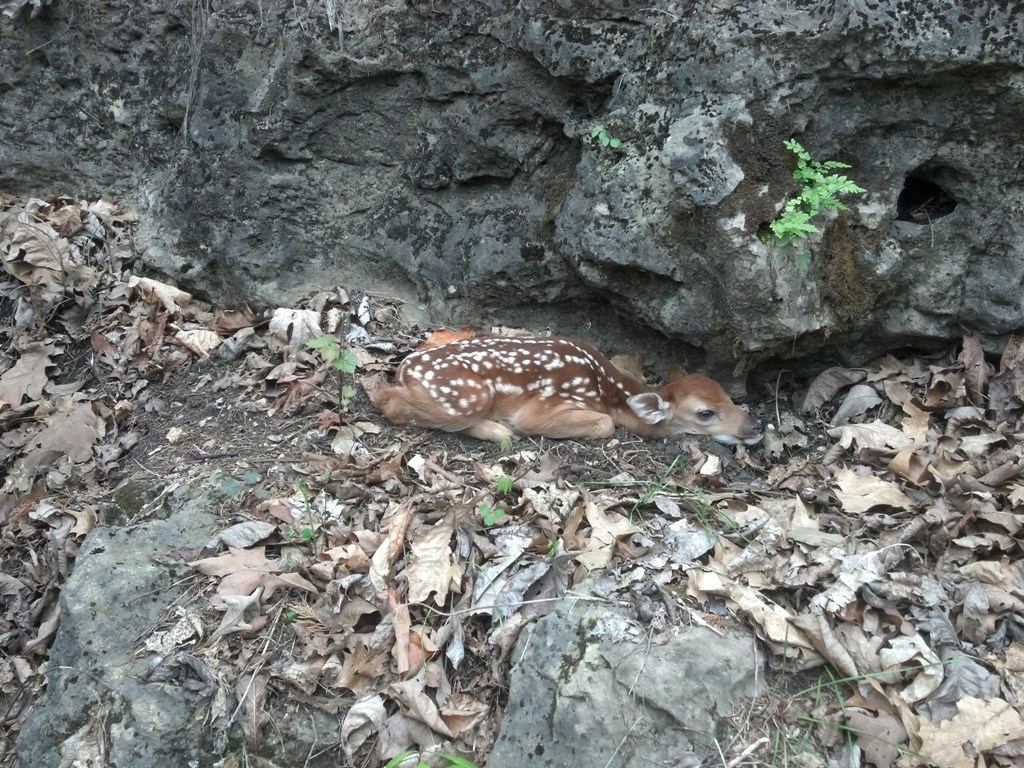
Most fawns are born during late May/early June but there are always those that are born a few weeks earlier or later.
Likewise there are probably a few turkey poults that have hatched already. Cold wet conditions will likely result in a 100% loss of those early born poults.
We can’t change (or even accurately predict) the weather. We can manage the habitat to provide quality food, cover, and water to help wildlife survive such storms. It’s critical to manage the wildlife populations so that there is more food than required during good conditions – as bad conditions will always occur.
We manage for very high quality native forage and cover at The Proving Grounds. There’s plenty to eat, fresh water to drink, and great cover for wildlife to seek during this arctic blast. Such storms have probably occurred before weather records were kept and they’ll probably occur again. That’s why quality habitat management is critical for allowing wild, free-ranging deer to express their potential. As managers, we can have an impact on the habitat quality and the amount of genetic potential the local herd expresses. We can’t impact the genetic quality of wild, free-ranging deer. I’m glad we can’t – that’s what makes them wild!
Growing Deer together,
Grant
After The Hunt: Cooking Wild Turkey
Grant and Adam have been busy turkey hunting this week so the writing of the blog falls to me! In considering topics I immediately knew I would not write about turkey hunting but quickly realized that I should write about what I do know – what to do with that turkey once it is “in the bag!”
When Grant and I first got married he learned that my cooking was often an “experiment” as I like to take a base recipe and “experiment” with my own ideas. Most of our meals were prefaced with “I hope this is okay. It’s kind of an experiment.” Fortunately most of my experiments turn out well! Over the years I have experimented with the venison, wild turkey and other wild meats Grant has harvested for our freezer.
I’ve become a competent wild game cook. By no means is my cooking gourmet. As a busy working mother I default to the easy recipes instead of the more complicated, fancy recipes.
Cooking wild turkey can be a bit of a challenge. Most hunters prize a “mature” tom as they are usually more challenging to hunt and a better trophy of bigger spurs and a longer beard. Being “mature” equates to old which equates to tough meat! Marinating and/or slow cooking in the crock pot are my preferred ways to turn a tough, old bird into a delicious meal for my family!
Last year I experimented with a new recipe for cooking wild turkey. Grant loved it! He said that this is his favorite way for me to cook the turkey, second only to deep frying breaded turkey nuggets.
Grant’s Favorite Wild Turkey Recipe
Serves 6
3 10 ounce cans green enchilada sauce
15 – 30 ounces chicken broth (enough to cover turkey breast)
1 large onion, chopped
3 cloves garlic, chopped
2 teaspoons ground cumin
1 teaspoon salt
1/2 teaspoon pepper
1 turkey breast (2 lbs or larger)
2 to 3 strips uncooked bacon
1 cup chopped fresh cilantro (optional; to taste)
2 tablespoons fresh lime juice
Serve with: warm flour tortillas and salsa
Mix all ingredients except turkey, uncooked bacon, cilantro, lime juice, tortillas and salsa in a 4 quart or larger slow cooker.
Add turkey wrapped in bacon strips.
Cover and cook on low 7 to 9 hours or until turkey is tender. Remove turkey to a cutting board.
Stir cilantro and lime juice into mixture in slow cooker. Shred turkey in bite size pieces; return to slow cooker.
Can be served as a soup/stew or use a slotted spoon to separate meat from liquid and serve burrito/taco style rolled up in flour tortillas with your choice of toppings: cheese, sour cream, shredded lettuce, or salsa. Accompany with refried beans, rice, salsa and chips. (If you choose to use the meat for a burrito/taco the remaining liquid makes a base for Mexican soup!)
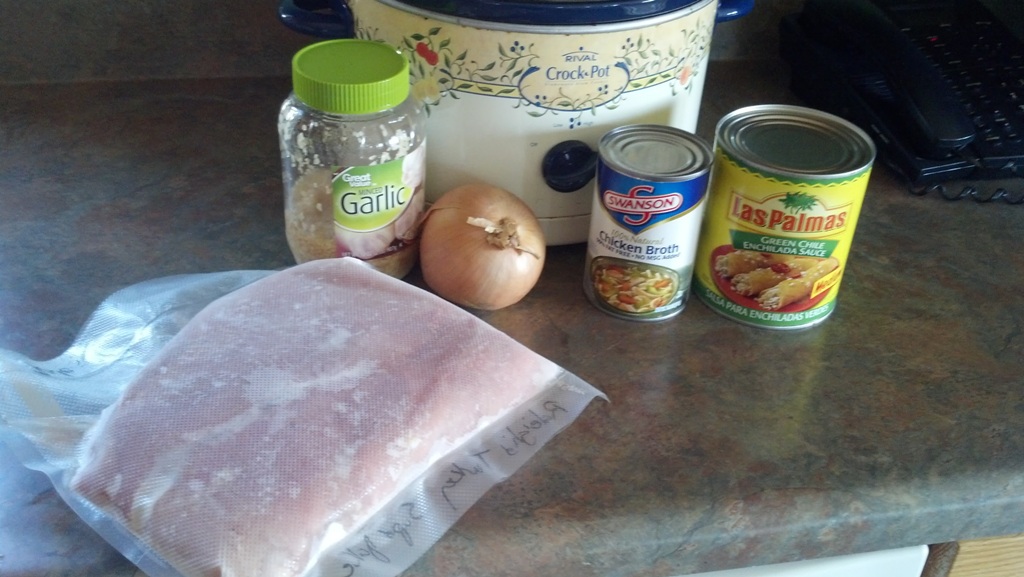
Slow cooking in the crock pot is one of my favorite ways to turn a tough, old bird into a delicious meal.
(The idea for this recipe is based on one for a Mexican pork dish I modified for venison that I call Venison Pozole.)
If you would like to try something new this year, check out these great recipes on the NWTF website or on the Bass Pro website.
Let us know your favorite recipes for cooking wild turkey by posting them on Grant’s Facebook page!
Enjoy!
Tracy Woods
Spring Turkey Hunting Strategies
The hillsides here at The Proving Grounds are slowly getting that green tint to them, the creek is flowing fast, and the gobblers are playing their song every morning. Spring is in the air here, FINALLY! Last year when Missouri turkey season opened, we had plenty of foliage and green leaves. This year’s opening day will be very different. Spring green up is occurring later than it has the last couple of years and the turkeys seem to be on that same schedule.
I’ve been asked several times lately if I’m still seeing a lot of birds in large flocks or winter to early spring flocks. The answer is yes and no. From running the Reconyx cameras to driving across the country side, I’m seeing a lot of birds in large flocks. I’m also seeing the occasional single tom out strutting in a field, but the majority of birds are still in groups. What does this mean? If you ask any turkey hunter who’s spent much time chasing turkeys they will tell you that calling to flocks isn’t nearly as effective as calling to lone gobblers. And why should it be? When a gobbler has an entire flock around him why would he leave them for one hen he can’t see? “Henned up” turkeys can also be indicated by their lack (if any) of gobbling when they fly off the roost in the morning. It will be difficult calling turkeys until they split up and we start finding more lone toms.
With the Missouri turkey season opening soon I thought I would discuss our strategy. Since we’re seeing more flocks than usual for this time of year, our game plan has changed. As much as I enjoy “running and gunning” for turkeys, it probably won’t be on the agenda for opening day this year. Hunting henned up toms that don’t gobble much is more like deer hunting. First we scout with ears, eyes, and Reconyx cameras to find the location where they are most active. Then we move in before sunrise to either a blind or a tree that we have previously picked. Finally, we generally use decoys and keep our calling softer and less aggressive. To me this type of turkey hunting is far less exciting than my favorite running and gunning style, but it can be just as effective if the cards are played right.
We’re only days away from one of my favorite events of the year! I can’t wait to wake up, pull on my LaCrosse boots, and head out in search of a gobbler. Good luck to all the hunters out there and stay safe!
Daydreaming of long beards and long spurs,
Adam



